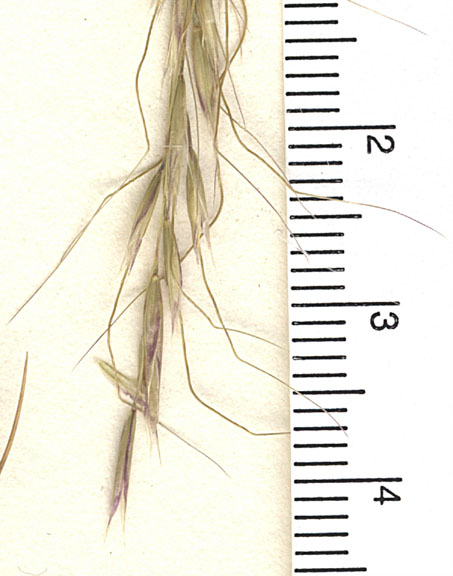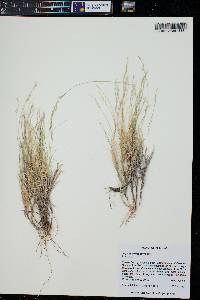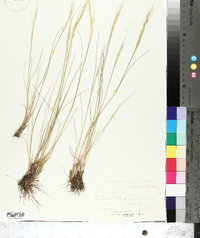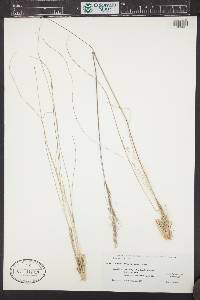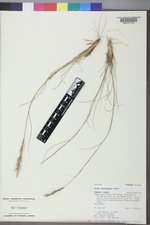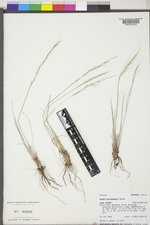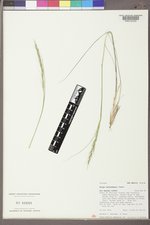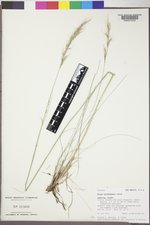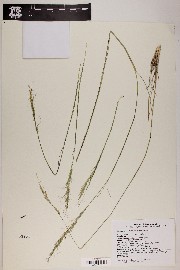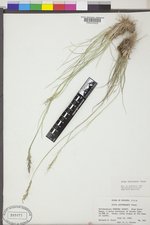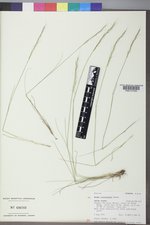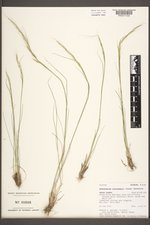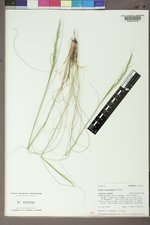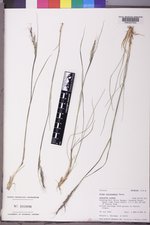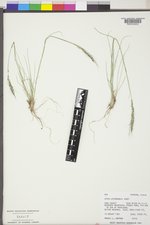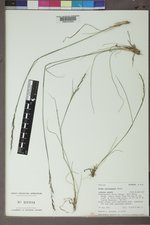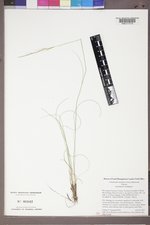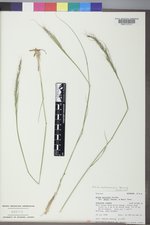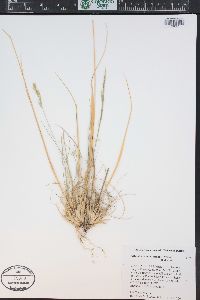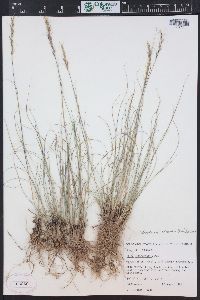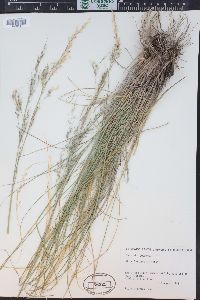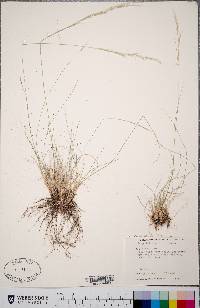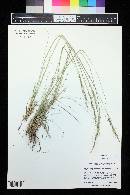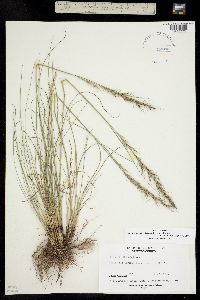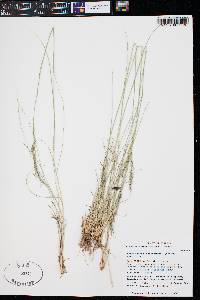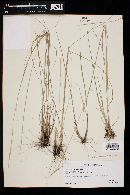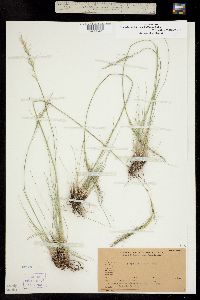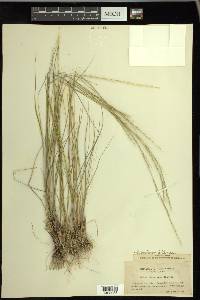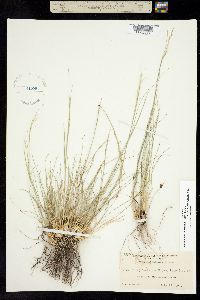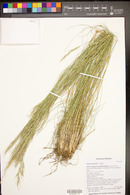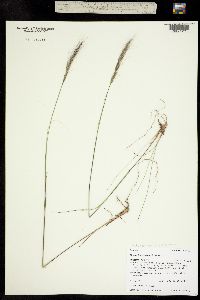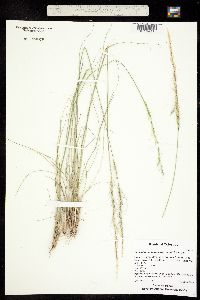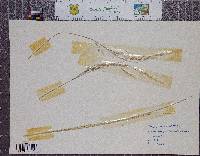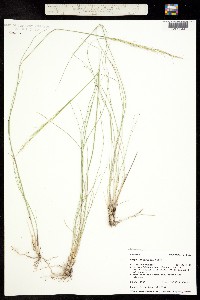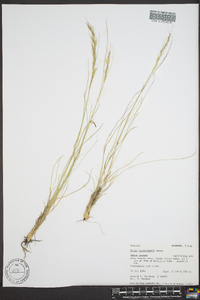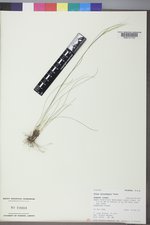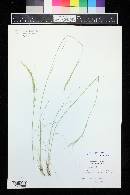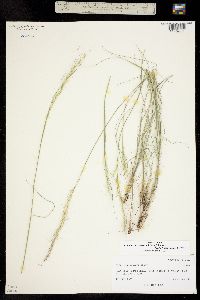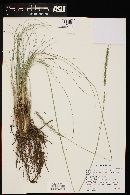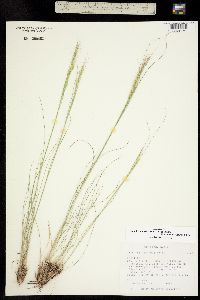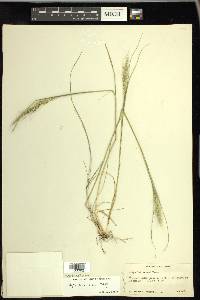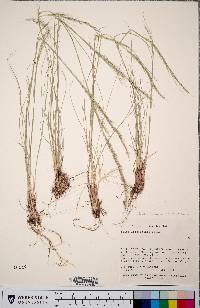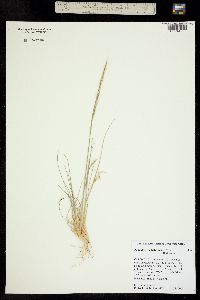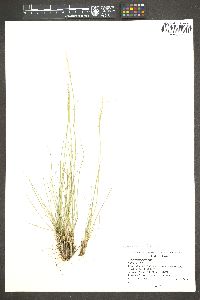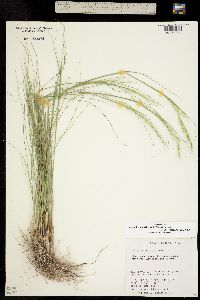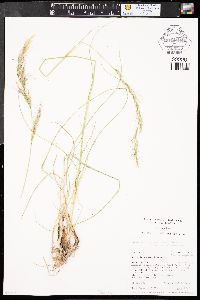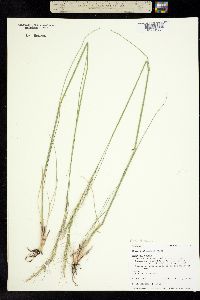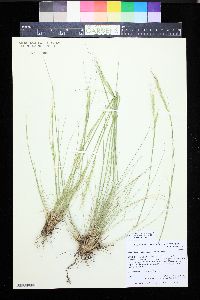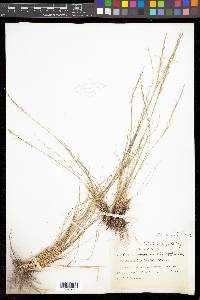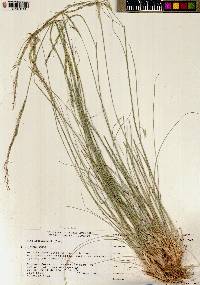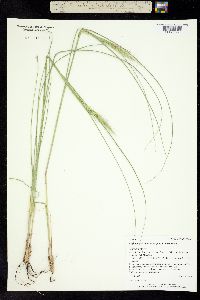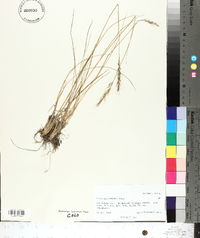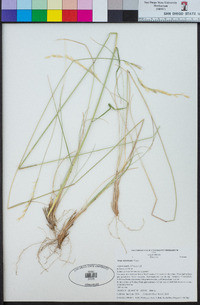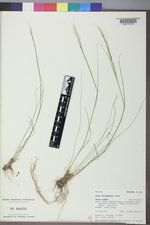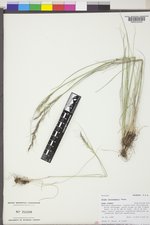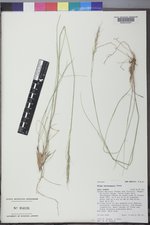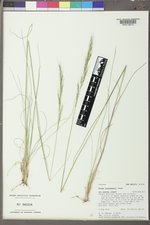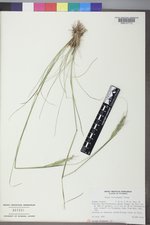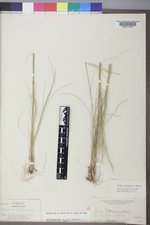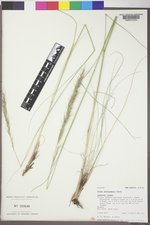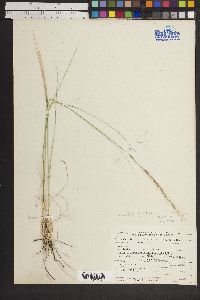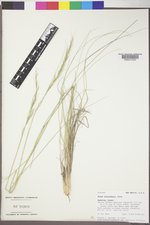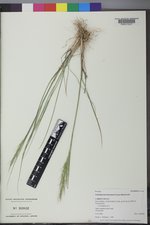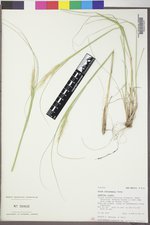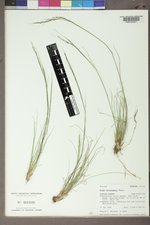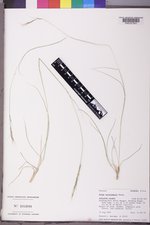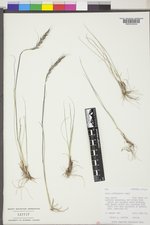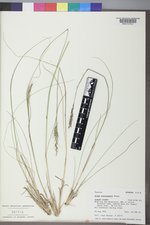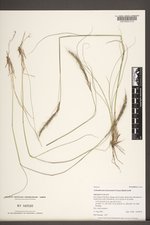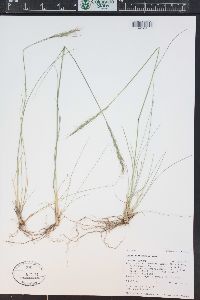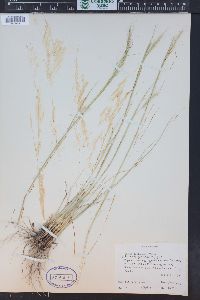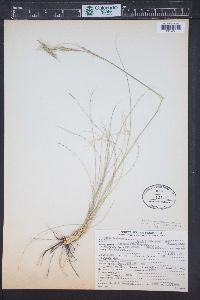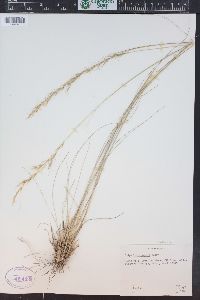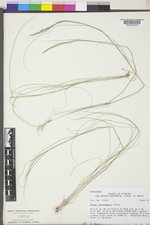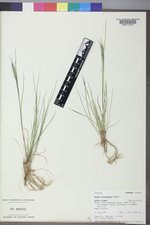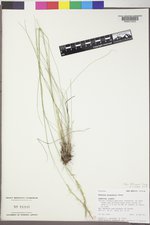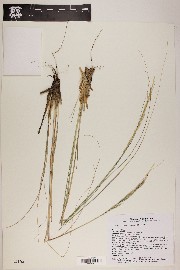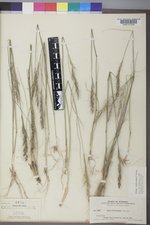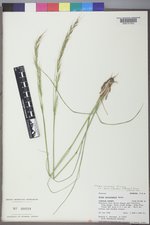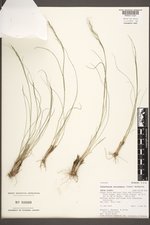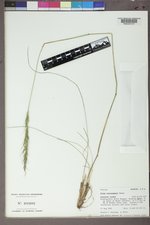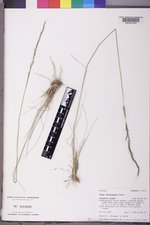
|
|
|
|
Family: Poaceae
Letterman's needlegrass, more...Letterman's Rice Grass, Letterman needlegrass, Letterman's Needlegrass
[Stipa lettermanii Vasey, moreStipa lettermannii Vasey, Stipa viridula var. lettermanii (Vasey) Vasey, Stipa viridula var. minor Vasey] |
Plants tightly cespitose, not rhizomatous. Culms 15-90 cm tall, 0.5-0.8 mm thick, usually glabrous, sometimes puberulent to 5 mm below the lower nodes; nodes 2-3. Basal sheaths smooth, glabrous, margins not ciliate; collars, including the sides, glabrous or sparsely pubescent, collars of the flag leaves glabrous; ligules 0.2-1.5(2) mm, without tufts of hair on the sides, truncate to rounded; blades 0.5-2 mm wide, abaxial surfaces smooth to scabridulous, adaxial surfaces scabrous or puberulent. Panicles 7-19 cm long, 0.5-1 cm wide; branches straight, appressed to strongly ascending, longest branches 1.2-2.5 cm. Spikelets appressed to the branches. Glumes 6.5-9 mm, subequal; lower glumes 1(3)-veined; upper glumes to 0.5 mm shorter than the lower glumes, 0.6-1 mm wide, 1-veined; florets 4.5-6 mm long, 0.8-1 mm thick, fusiform, terete, widest below midlength; calluses 0.4-1 mm, blunt; lemmas evenly hairy, hairs at midlength about 0.5 mm, apical hairs 0.7-1.5(2) mm, apical lobes 0.3-0.8 mm, membranous, flexible; awns 12-25 mm, persistent, twice-geniculate, scabrous, terminal segment straight; paleas 3-4 mm, 3/4-4/5(9/10) as long as the lemmas, veins terminating at or before the apices, apices round, flat, apical hairs 0.5-1 mm, extending beyond the palea body; anthers 1.5-2 mm, dehiscent, not penicillate. Caryopses about 4 mm, fusiform. 2n = 32. Achnatherum lettermanii grows in meadows and on dry slopes, from sagebrush to subalpine habitats, at 1700-3400 m. Its range extends from Oregon and Montana to southern California, Arizona, and New Mexico; it is not known from Mexico. When sympatric with A. nelsonii, A. lettermanii tends to grow in shallower or more disturbed soils. It can be distinguished from that species by its generally finer leaves and more tightly cespitose growth habit, as well as its blunter calluses and longer paleas. Its relatively long paleas also distinguish A. lettermanii from A. perplexum. Dr. David Bogler, USDA NRCS PLANTS Database Perennials, Terrestrial, not aquatic, Stems nodes swollen or brittle, Stems erect or ascending, Stems caespitose, tufted, or clustered, Stems terete, round in cross section, or polygonal, Stem internodes hollow, Stems with inflorescence less than 1 m tall, Stems, culms, or scapes exceeding basal leaves, Leaves mostly basal, below middle of stem, Leaves mostly cauline, Leaves conspicuously 2-ranked, distichous, Leaves sheathing at base, Leaf sheath mostly open, or loose, Leaf sheath smooth, glabrous, Leaf sheath and blade differentiated, Leaf blades linear, Leaf blades very narrow or filiform, less than 2 mm wide, Leaf blade margins folded, involute, or conduplicate, Leaf blades mostly glabrous, Leaf blades scabrous, roughened, or wrinkled, Ligule present, Ligule an unfringed eciliate membrane, Inflorescence terminal, Inflorescence a contracted panicle, narrowly paniculate, branches appressed or ascending, Inflorescen ce a dense slender spike-like panicle or raceme, branches contracted, Inflorescence solitary, with 1 spike, fascicle, glomerule, head, or cluster per stem or culm, Flowers bisexual, Spikelets pedicellate, Spikelets dorsally compressed or terete, Spikelet less than 3 mm wide, Spikelets with 1 fertile floret, Spikelets solitary at rachis nodes, Spikelets all alike and fertille, Spikelets bisexual, Spikelets disarticulating above the glumes, glumes persistent, Spikelets disarticulating beneath or between the florets, Rachilla or pedicel glabrous, Glumes present, empty bracts, Glumes 2 clearly present, Glumes equal or subequal, Glumes equal to or longer than adjacent lemma, Glumes 3 nerved, Lemma 5-7 nerved, Lemma body or surface hairy, Lemma apex acute or acuminate, Lemma distinctly awned, more than 2-3 mm, Lemma with 1 awn, Lemma awn 1-2 cm long, Lemma awned from tip, Lemma awn twisted, spirally coiled at base, like a corkscrew, Lemma awn twice geniculate, bent twice, Lemma m argins inrolled, tightly covering palea and caryopsis, Lemma straight, Callus or base of lemma evidently hairy, Callus hairs shorter than lemma, Lemma surface pilose, setose or bristly, Palea present, well developed, Palea membranous, hyaline, Palea shorter than lemma, Stamens 3, Styles 2-fid, deeply 2-branched, Stigmas 2, Fruit - caryopsis, Caryopsis ellipsoid, longitudinally grooved, hilum long-linear.
FNA 2007, Man. Grasses of NA 2007, Ann. Checklist GCNP 1987 Common Name: Letterman's needlegrass Duration: Perennial Nativity: Native Lifeform: Graminoid General: Perennial bunchgrass to 80 cm tall with short, curled leaves and an inflorescence with open branches and few spikelets. Vegetative: Plants in dense clumps with slender stems 15-90 cm tall, usually glabrous, sometimes puberulent just below the lower nodes. Basal sheaths and collars glabrous, truncate to rounded. Ligules 1 mm without tufts of hair, curled leaf blades 1-2 mm wide, abaxia Inflorescence: Panicles 5-20 cm long, up to 1 cm wide, branches straight and ascending, 1-2 cm long, spikelets close to the branches, glumes 6-9 mm long, subequal, florets 4-6 mm long and 1 mm thick and fusiform, lemmas hairy, membranous and flexible, awns 1-2 cm long with a straight terminal segment, paleas 3-4 mm long and same length as the lemmas, with short apical hairs extending beyond the paleas, awn 1-2 cm, bent twice. Ecology: Found on meadows and dry slopes in sagebrush and subalpine coniferous forests from 1500-3500 m, flowers June-September. Distribution: Troughout the West except Washingtom. Notes: Grows alongside A. nelsonii but can be distinguished by its more tightly clumped growth habit, finer leaves, longer paleas, and its ability to grow in shallower or more disturbed soils. It can also be distinguished from A. perplexum by its long paleas. Ethnobotany: Unknown Etymology: Achnatherum comes from Greek achne for chaff and ather for stalk, referring to the lemma. Lettermanii is named after the botanist Washington Letterman (1841-1913). Editor: Lkearsley, 2012 |

